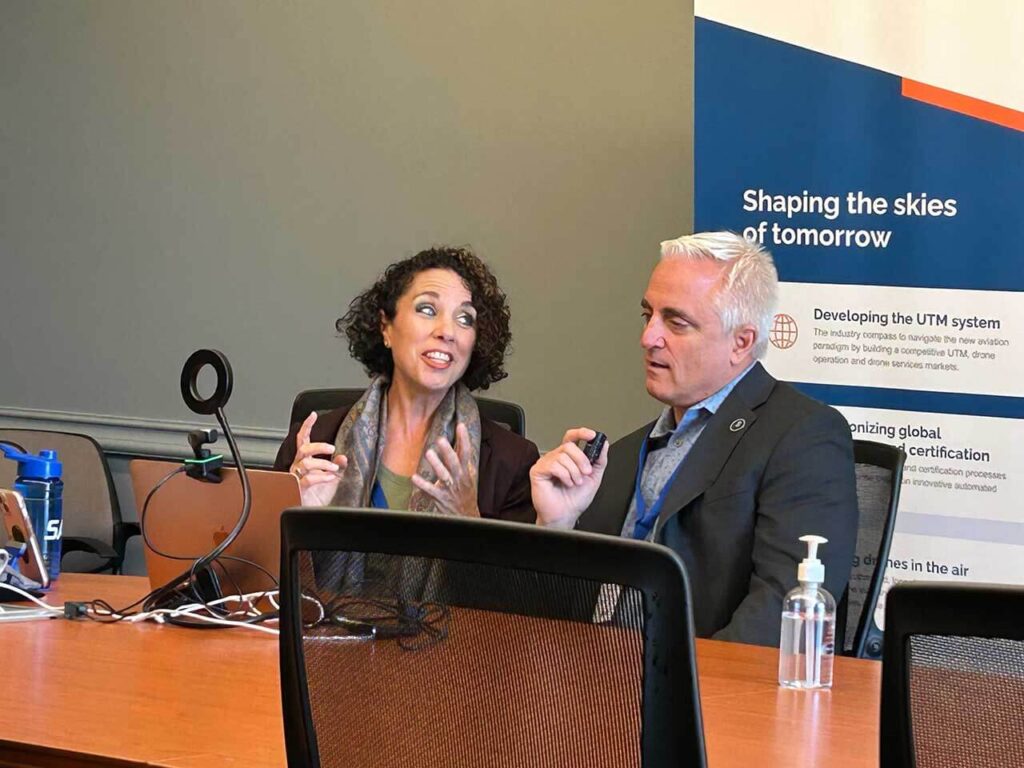Uncrewed Aircraft System Traffic Management (UTM) will reshape the future of aviation by enabling drones and other uncrewed aircraft to safely share airspace with traditional aviation. As UTM services proliferate worldwide, the process for approving these digital solutions in a way that balances innovation, safety and scalability has become a focal point for regulators, industry leaders and technology developers.
Drawing on discussions from a global panel at GUTMA’s Harmonized Skies event, featuring experts from the U.S. Federal Aviation Administration (FAA), the Australian Civil Aviation Safety Authority (CASA), Wing, TruWeather Solutions and Involi, this article explores how UTM services have been approved, the role of automated testing in that process, the importance of standards and collaboration and what the future holds in terms of regulator and service provider next steps.
Their insights seem particularly poignant now more than ever, as the Part 108 beyond visual line of sight (BVLOS) rule-making release may be imminent. Rumor has it that the timeline is in the next 60 days and that the page count will be around 1000. We’ve injected our own practice tips so you can get ready for the Notice of Public Rule Making (NPRM).

The Regulatory Landscape: Performance-Based and Collaborative Approaches
Agility in Regulation
Regulators such as the FAA and CASA remain acutely aware of the need for agility in the fast-moving UAS industry.
Jessica Brightman, Manager of the FAA’s Implementation Branch, UAS Integration Office, emphasized that the FAA is moving toward performance-based standards rather than prescriptive rules. This approach allows industry to propose creative, risk-mitigating solutions that can adapt as technology evolves. The FAA focuses on identifying operational risks and ensuring that these are mitigated, whether through technology, operational procedures, or a combination of both. Brightman also indicated that, “Standards help guide this process and allow regulations to be flexible as technology evolves.”
Practice Tips: Given the emphasis on standards, it’s probably worth checking out key ASTM and other standards for UTM. Here is a short list of prominent standards and initiatives:
- ASTM F3548-21: Standard Specification for UAS Traffic Management (UTM) UAS Service Supplier (USS) Interoperability. This is a global specification for interoperability between UTM service providers, covering requirements such as conflict detection, conformance monitoring, constraint awareness, and situational awareness for nonconforming operations.
- Remote Identification Standards: ASTM F38 is also developing standards for remote identification and surveillance services as part of the broader UTM ecosystem.’
- ANSI UAS Standardization Collaborative (UASSC): Drafting a Standardization Roadmap for Unmanned Aircraft Systems, which includes UTM-related standards and gaps.
- JARUS (Joint Authorities for Rulemaking on Unmanned Systems): Developing regulatory frameworks and operational risk assessment (SORA) methodologies for UTM, focusing on division of responsibilities, oversight, and risk modeling.
- ICAO UTM Guidance: ICAO has published “UTM – A Common Framework with Core Boundaries for Global Harmonization,” providing international guidance for harmonized UTM implementation.
Weather Standards Provide A Piece of the Foundation
The development and adoption of industry standards, such as ASTM F3548-21 for UTM interoperability, remain central to scalable, repeatable UTM approvals.
Don Berchoff of TruWeather Solutions described how he led the development of new standards for weather data to enable third-party providers to integrate micro-weather information into UTM systems. This, he said, will improve operational decision-making and safety.
“We built a system so that the standard, and the way you approach it, will ensure reliability and security,” he said. “More innovation and better technologies will follow, driven by market demand and regulatory acceptance” Berchoff predicted.
Practice Tips: Definitely review the weather standard for UTM, ASTM F3673-23. It addresses performance standards for weather information reports, data interfaces and Weather Information Providers (WIPs) to support UTM and related aviation operations. The FAA is expected to, outside of the BVLOS NPRM, develop an Advisory Circular that adopts this ASTM weather standard.
Near-Term Approval Process (NTAP)
In the United States, the FAA developed the Near-Term Approval Process (NTAP) to expedite the evaluation and approval of UTM services. NTAP is not a certification process but rather a risk-based evaluation that allows operators to receive “safety credit” for using approved UTM services when seeking waivers or exemptions.
The process involves the submission of a Concept of Use (CONUSE), Concept of Operations (CONOPS), Service Level Agreement (SLA), Requirements Traceability Matrix (RTM) and a Safety Risk Management (SRM) plan. Once approved, a Memorandum of Agreement (MOA) is signed and the service can be leveraged in operational approvals.
Practice Tips: The BVLOS rule may contain many of these same components, as they will be tried and tested. Learn more about NTAP and UTM at the FAA’s website here.
Global Harmonization and Repeatability
A recurring theme among panelists was the need for global harmonization. Brendan Hillis of Wing highlighted the benefits of being able to deploy a UTM solution in one country and adapt it for use in another with minimal changes, thanks to harmonized standards and testing regimes. This approach not only accelerates deployment but also reduces the regulatory burden for both operators and authorities.
Practice Tips: The Global UTM Association (GUTMA) plays a huge role in global harmonization of UTM. Its website contains a ton of great resources. Their next Harmonized Skies event will take place in November in Zurich, Switzerland. There should be great strides on the regulatory and operational fronts by then.

The Role of Automated Testing in UTM Approval
Onboarding and Continuous Validation
The onboarding process for UTM services, at least for now, this typically involves:
- Signing a governance agreement.
- Completing automated testing within a set timeframe (e.g., 60 days).
- Gaining observer status in technical and operations committees.
- Achieving compliance before full integration into any given UTM ecosystem.
Automated testing, the use of automated test environments to verify interfaces, input/output (IO), and connectivity between UTM system components, has emerged as a cornerstone of UTM service approval. Reports generated from these tests provide clear, actionable feedback for both developers and regulators. Both the U.S. and Australia use automated testing for onboarding new UTM services, ongoing oversight and verifying compliance with evolving standards.
Automated Testing: Building Confidence and Efficiency
These automated test environments can run tests much faster and more efficiently than manual testing. They allow for the confirmation that UTM software meets functional, safety and performance criteria established by regulations. Such testing commonly uses standardized test scripts, emulators, and simulators to verify requirements and compliance, supporting certification and ongoing monitoring of UTM service.
“Automated testing allows us to test interoperability and compliance with standards. It sets a very clear, performance-based bar: you pass the test or you don’t,” Brightman explained. She continued, “This approach reduces resource requirements for regulators and provides a clean, repeatable process.”
Practice Tips: Where does this all happen? For one, the New York UAS Test Site (NYUASTS), operated in partnership with AX Enterprize, LLC, at Griffiss International Airport in Rome, NY. The team there provides a configurable UAS testbed with robust network infrastructure to support complex UTM test events. including automated testing of UTM capabilities, interoperability and performance for both industry and government partners. Expect the need for these services to snowball, once the FAA releases the NPRM.
Interoperability and Pairwise Testing
Automated testing is not limited to individual systems. Pairwise interoperability tests ensure that new releases from one service provider do not disrupt the broader ecosystem. This is critical in a decentralized, multi-provider environment where seamless data exchange and coordination remain essential for safety and efficiency.

Leveraging Open Source Solutions
Open source solutions, such as those developed under the Linux Foundation, are playing a significant role in accelerating UTM deployment. By contributing to shared codebases and testing frameworks, industry stakeholders can harmonize requirements, reduce duplication of effort, and increase transparency.
Practice Tips: You can review all the documents and code for the U.S. UTM Implementation on GitHub. This portal helps UTM stakeholders manage onboarding, testing and governance. It also makes the process accessible and collaborative.
The Future: Precision, Risk-Based Approaches and Global Harmonization
Resource Constraints and Scalability
Regulators globally face significant resource constraints as they work to integrate rapidly growing UAS operations. Collaborative governance, automated testing and standardized documentation all help them to manage this complexity and ensure scalability.
Repeatability and Efficiency
One of the most effective strategies for reducing regulatory workload is to create repeatable approval pathways. Once a UTM service or supplemental data provider is approved for a specific risk mitigation, subsequent operators can leverage that approval. This reduces the need for redundant reviews. This approach not only accelerates deployment but also encourages service providers to invest in robust, well-documented solutions.
Toward Certification and Lifecycle Regulation
While current processes like NTAP provide a practical pathway for near-term approvals, there is broad recognition of the need for a more formal certification framework. The FAA is actively engaged in rulemaking to create a regulatory structure for third-party data sources and UTM services, which will further streamline approvals and provide greater certainty for industry stakeholders.
Precision and Detail Matter
As UTM systems mature, the focus will shift from broad enablement to precision, ensuring that every detail, from data quality to interoperability, is addressed. Berchoff noted that the industry must “get the little things right.” Leveraging advanced analytics and continuous integration will drive safety and efficiency.
Risk-Based, Mission-Specific Solutions
Not all UTM operations are created equal. Different missions and platforms entail different risks and require tailored risk assessments and mitigations. Regulators and service providers must work together to identify these risks and develop targeted solutions, rather than applying a one-size-fits-all approach.
Global Collaboration and Standards Development
The path forward lies in continued global collaboration through organizations like ASTM, ICAO, and the Global UTM Association and the development of harmonized standards that enable interoperability and repeatable approvals. As more countries adopt and adapt these frameworks, the vision of seamless, scalable UTM services will become a reality.
For example, Australia’s approach to UTM is characterized by a strong emphasis on collaboration and a shared vision. The CASA views UTM as an enabler for integrating emerging technologies with traditional aviation, unlocking benefits for all airspace users. The process is iterative, starting simple and becoming more complex as integration with crewed aviation deepens.
The UK is hosting shared airspace UTM trials involving multiple service providers and public safety agencies, following successful deployments in Texas. Switzerland is also exploring interoperable UTM solutions with multiple providers engaging with the national regulator. These initiatives underscore the global momentum toward decentralized, interoperable UTM systems that can be adapted to local needs while maintaining global compatibility.

A Blueprint for Scalable, Safe and Innovative UTM Services
Approving UTM services is a complex, evolving challenge that sits at the intersection of technology, regulation and industry collaboration. The experiences shared by these global leaders highlight the importance of performance-based standards, automated testing, open source collaboration and risk-based approaches. As the landscape continues to evolve, the lessons learned in North Texas, Australia and Europe provide a blueprint for the future. By focusing on repeatability, interoperability and harmonization for UTM, regulators and industry create safe airspace where innovation and safety go hand in hand and where global collaboration drives the next wave of aviation transformation.
UTM services have been implemented to facilitate strategic coordination here in North Texas. But how are UTM apps and services approved by regulators? Hear from a diverse range of perspectives about approving services, leveraging open source solutions, onboarding to a discovery and synchronization service (DSS), evaluating and leveraging these services as a regulator, and examples in live services around the world.
This article is largely based on insights from a UTM approval panels at the GUTMA Harmonized Skies 2024 event consisting of civil aviation authority and industry leaders.
Watch the author, several of these UTM leaders and others on the Full Crew event steam from GUTMA’s Harmonized Skies event.
Mark your calendars now to attend GUTMA’s Harmonized Skies 2025 in November in Zurich, Switzerland.
By: Dawn Zoldi

